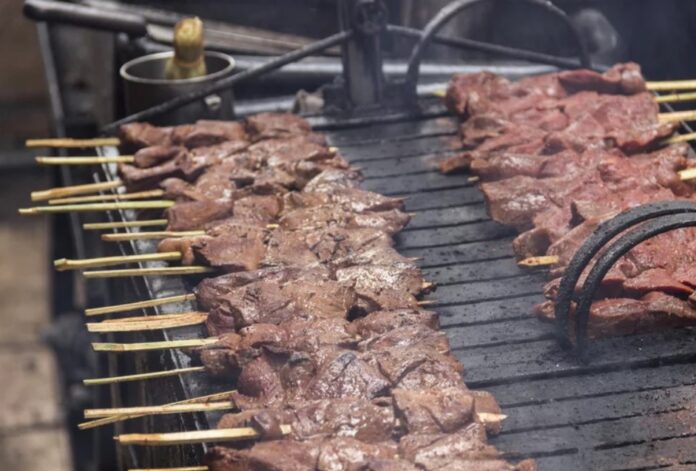Anticuchos, derived from the Quechua term
‘Anti Kuchu’ (Anti: ‘Eastern region of the Andes’ or ‘Eastern native ethnicities’, Kuchu: ‘Cut’), represent a cherished and budget-friendly culinary tradition hailing from the Andes, originating in the Antisuyu region of the Tawantinsuyu (Inca Empire) during the pre-Colombian era. This gastronomic delight evolved during the colonial period between the 16th and 19th centuries and has become a culinary staple in modern-day Peru.
Typically sold from street-carts and food stalls known as anticucheras, these delectable dishes feature meat, often marinated in a mixture of vinegar and spices like cumin, ají pepper, and garlic. While anticuchos can be crafted from various meats, the most popular variant involves beef heart, known as anticuchos de corazón. A customary accompaniment to anticuchos is a boiled potato at the end of the skewer. Drawing parallels with Mediterranean cuisine, a similar dish known as shish kebab exists. In Peru, anticuchos are intricately linked to the Señor de los Milagros procession.
Historically, anticuchos find their roots in Pre-Columbian times, with their modern incarnation dating back to the 16th century when Spanish conquistadors first encountered them. This period saw the integration of European ingredients, such as garlic, and a shift from traditional llama meat to beef. Initially favored within the Inca Empire, anticuchos have transcended regional boundaries and are now beloved throughout much of South America, sometimes taking on Americanized variations featuring non-organ meats.
The term “anticucho” is believed to stem from the Quechua antikuchu (anti: ‘East’ + kuchu: ‘cut’ or uchu: ‘porridge, mix), according to a text file from the National Library in Lima, Peru. Tradition holds that anticuchos were originally prepared with meat and fire, with the Spanish later adapting the method by skewering the meat on sticks.
The Spaniards’ introduction of enslaved Africans in Lima and the southern coast of Chico de la Ciudad de los Reyes during the Vice-royalty of Peru influenced the dish. At the time, the Spanish regarded offal as suitable only for slaves, favoring “prime” cuts. This legacy endures in Peru, where anticuchos maintain their traditional name and ingredients, enjoyed by people of all social classes and particularly cherished as a popular street food.

Anticucho (Peru)
Anticuchos are a kebab-like street food found in Peru that can consist of any kind of meat but are most popularly made of beef heart. The meat is marinated in vinegar and spices such as garlic, cumin and ají pepper before being roasted on a skewer, the meat pieces alternating with vegetables such as peppers, onions, mushrooms and carrots. Seasoned with salt, as well as sometimes vinegar or lemon juice, anticuchos are usually served with a traditional sauce made with garlic, cilantro, onion, lemon juice, beer and vinegar, as well as a piece of bread or a boiled potato.



